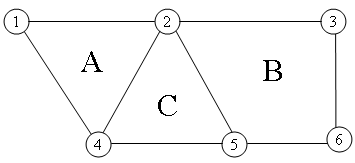Class Name: Mesh Face Table
Subclasses
This DRM class is concrete and has no subclasses.
Definition
An instance of this DRM class specifies a two-dimensional table
that defines the face elements of a
<Finite Element Mesh> instance in
terms of vertex numbers in the ordered <Vertex>
component list of the
<Finite Element Mesh> instance and,
optionally, the topology of the face elements.
The first data element specifies, for cell i, j, the index in the ordered
<Vertex> list of the <Vertex>
representing the jth vertex of the ith mesh
face. If the ith mesh face contains less than j vertices,
so that j is greater than the number of the last listed vertex of
mesh face i, the cell data element contains zero (0). The edges
of each mesh face i are implicitly defined by pairing vertex j to
vertex j + 1.
For a given mesh face element index i and mesh face vertex index j, the
(i, j)th cell gives the vertex number that comprises the jth vertex of
the ith mesh face. The mesh face vertices are listed (j index) in
clockwise order around the outer perimeter of the mesh face, starting
and ending with a first vertex. If inner perimeter rings are present,
the vertex list along the second axis continues with inner perimeter
vertices in counterclockwise order starting and ending with a first
vertex on each inner ring.
Primary Page in DRM Diagram:
Secondary Pages in DRM Diagram:
This class appears on only one page of the DRM class diagram.
Example
Consider six <Vertex> instances, used to
define a <Mesh Face Table> instance, where
the mesh is diagrammed as depicted in Figure 6.33:

Figure 33 — <DRM Mesh Face Table> example
In this example, there are six <Vertex>
instances forming the vertices of the mesh, which has three
mesh faces (A, B, C).
The corresponding
<Mesh Face Table> instance,
without surface topology, is organized as follows,
where each individual cell contains a vertex
number.
| Vertex number |
| |
1 |
2 |
3 |
4 |
5 |
| 1 (Mesh Face A) |
1 |
2 |
4 |
1 |
0 |
| 2 (Mesh Face B) |
2 |
3 |
6 |
5 |
2 |
| 3 (Mesh Face C) |
4 |
2 |
5 |
4 |
0 |
Consider the
<Mesh Face Table>
instance from the previous example, with the addition
of surface topology indicated by
adjacent_face_table_present
set to SE_TRUE.
In this instance, each individual cell contains
a {vertex number, adjacent mesh face number} pair.
| Vertex number |
| |
1 |
2 |
3 |
4 |
5 |
| 1 (Mesh Face A) |
1, 0 |
2, 3 |
4, 0 |
1, 0 |
0, 0 |
| 2 (Mesh Face B) |
2, 0 |
3, 0 |
6, 0 |
5, 3 |
2, 0 |
| 3 (Mesh Face C) |
4, 1 |
2, 2 |
5, 0 |
4, 0 |
0, 0 |
FAQs
-
Where can users obtain further information about the
<Mesh Face Table> class and its usage?
See P4V6
of the SEDRIS Documentation Set for detailed information on
<Mesh Face Table> instance manipulation.
-
The <Mesh Face Table> class does not
have a field for the actual cells of a
<Mesh Face Table> instance. Where are they,
and how are they accessed?
The actual cells of a <Mesh Face Table>
instance are hidden by the API implementation being used to
provide the <Mesh Face Table> instance. See the
SE_PutMeshFaceTableData()
function in the level 0 API
for <Mesh Face Table> instance production,
and the level 0 function
SE_GetMeshFaceTableData()
for consumption.
Constraints
Component of (two-way)
Inherited Field Elements
This class has no inherited field elements.
Notes
Fields Notes
The mesh_face_count
field specifies the total number of mesh faces in the
<Mesh Face Table> instance.
The maximum_vertices_per_face
field specifies the maximum
number of vertices in any one face element.
If the
adjacent_face_table_present
field is set to SE_TRUE, the given
<Finite Element Mesh> instance
contains face adjacency information in a separate table termed the
adjacent face table, which has the same dimensions as the
mesh face table. The values in the adjacent face table are positive
integer values that specify face indexes that represent the row in the
mesh face table.
Prev: Map Scale LOD Data.
Next: Model.
Up:Index.
